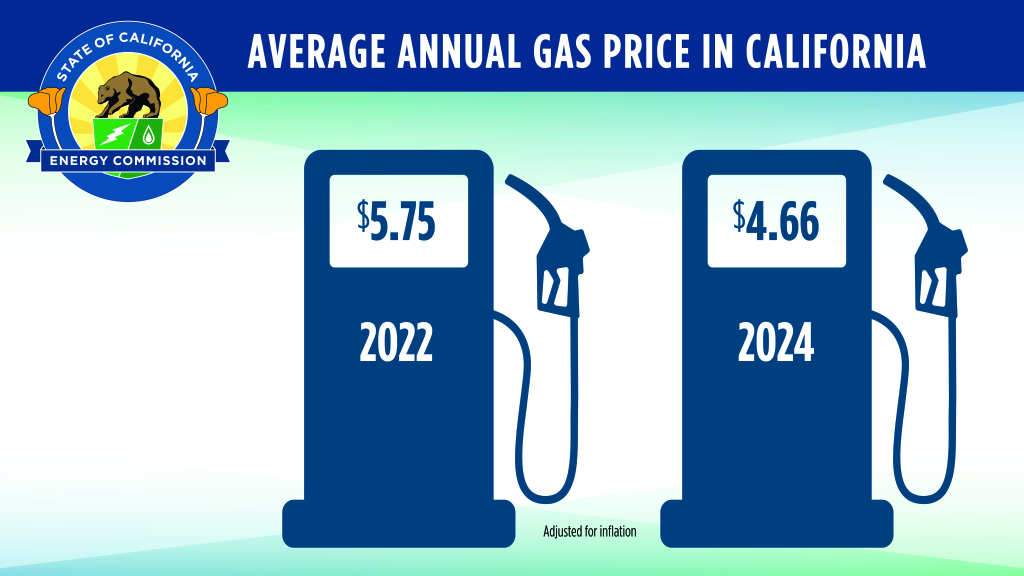For Immediate Release: December 19, 2024
WHAT YOU NEED TO KNOW:
The annual average price of a gallon of gasoline is 20 cents lower than last year and 70 cents lower compared to 2022, saving Californians billions in avoided costs.
SACRAMENTO – Californians are paying less to fill up at the pump, with the annual average price for gasoline at a 3-year low, due in part to the state’s efforts to protect consumers and improve transparency of the petroleum industry.
State officials can better understand supply, demand, and price trends in the petroleum market because of transparency and accountability tools that can be used thanks to new laws signed by Governor Gavin Newsom in recent years.
While data on total gasoline sales and prices through the end of the year is still being collected and analyzed, Jeremy Smith, deputy director of the California Energy Commission’s Energy Assessments Division, provided an overview about what is being done to implement Senate Bill X1-2 and what is ahead for 2025 at the December 11 business meeting.
The annual average price for gasoline in California is on track to be 20 cents per gallon less than 2023 and 70 cents per gallon lower than 2022 – adjusted for inflation, that’s more than $1 less per gallon. This equates to an avoided cost to Californians of about $2.5 billion compared to 2023 and $9.3 billion compared to 2022, Smith said.
State officials said efforts to protect consumers from gasoline price spikes at the pump and increase transparency of the petroleum industry is a challenging, but critical focus as California continues its transition to a clean energy future.
CEC Vice Chair Siva Gunda emphasized the state is committed to ensuring there is a safe, reliable, affordable, and equitable supply of transportation fuels during this transition.
“There will be some tough choices ahead and they will not be easy, but it’s important for us to work collaboratively while taking into account the needs of the communities, labor, and workforce safety,” he said.
The CEC is closely tracking gas prices as part of SB X1-2, looking at the influence of several factors, including gasoline supply and refinery maintenance.
Smith talked about the data transparency and analysis activities that CEC is implementing under the law, including the following:
- Expanded data collection efforts and analyzed tens of thousands of data submissions to improve understanding of the petroleum market.
- Collected more detailed information on the timing and impact of refinery maintenance events to better understand how outages affect supply and prices.
- Partnered with the California Department of Tax and Fee Administration to publish a report on gasoline prices and its impact on state revenues in May 2024.
- Published a transportation fuels assessment report in August 2024. The report describes the current state of the California transportation fuels market and identifies numerous policy options to mitigate price spikes and ensure a stable fuel supply.
WHAT’S NEXT
Governor Newsom signed Assembly Bill X2-1 in October 2024. The legislation authorizes the CEC to require refiners to plan for resupply during refiner maintenance outages to avoid supply shortages that create higher gasoline prices for consumers and higher profits for the industry.
It also allows the CEC to require oil refiners to maintain a minimum inventory of fuel. It could help prevent price spikes that the CEC estimates cost Californians more than $1 billion last year.
In light of new tools provided by the AB X2-1, the CEC will take taking a holistic approach by prioritizing developing refinery resupply and minimum inventory requirements in tandem with the potential maximum margin and penalty. SB X1-2 authorizes the CEC to set a maximum gross gasoline refining margin and a whether to impose a penalty for refiners that exceed it.
CEC staff is looking at how resupply and minimum inventory rules could interact with a margin and penalty with plans to present a high-level framework next spring.
Feedback from Commissioners, stakeholders, and the public will inform the final proposals, which are being developed together.
Details of the proposal will be discussed as part of a formal rulemaking that will launch after AB X2-1 goes into effect on January 13, 2025. An open, transparent public process will inform draft rules that will ultimately be voted on by the full commission at a future business meeting.
HOW WE GOT HERE
Following gasoline price spikes in 2022, Governor Newsom signed SB X1-2, a package of reforms to increase accountability of the petroleum industry. The law was signed in March 2023 and took effect June 2023.
The Division of Petroleum Market Oversight (DPMO) is an independent division within the CEC that was created as part of SB X1-2. The petroleum watchdog agency is responsible for carrying out the activities in the law focused on market oversight and investigation.
DPMO found that higher gasoline prices were caused by a suspicious market transaction, refinery maintenance without properly preparing for it, and more.
In January 2024, the watchdog sent Governor Newsom and the legislature a letter outlining specific proposals to reform California’s gasoline spot market, which included a minimum inventory requirement to prevent price spikes due to lack of stable supply.
###
About the California Energy Commission
The California Energy Commission is the state's primary energy policy and planning agency. It has seven core responsibilities: advancing state energy policy, encouraging energy efficiency, certifying thermal power plants, investing in energy innovation, developing renewable energy, transforming transportation, and preparing for energy emergencies.
Newsroom
Media Contact
Media and Public Communications Office
MediaOffice@energy.ca.gov
(916) 654-4989

